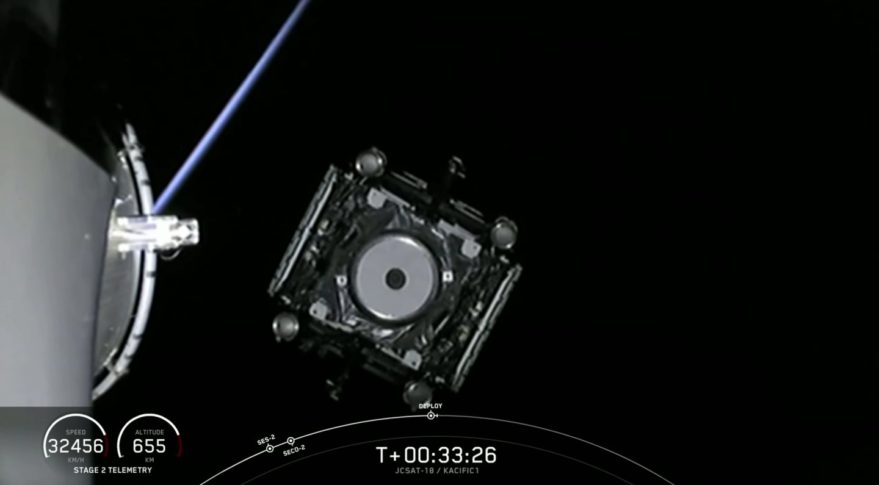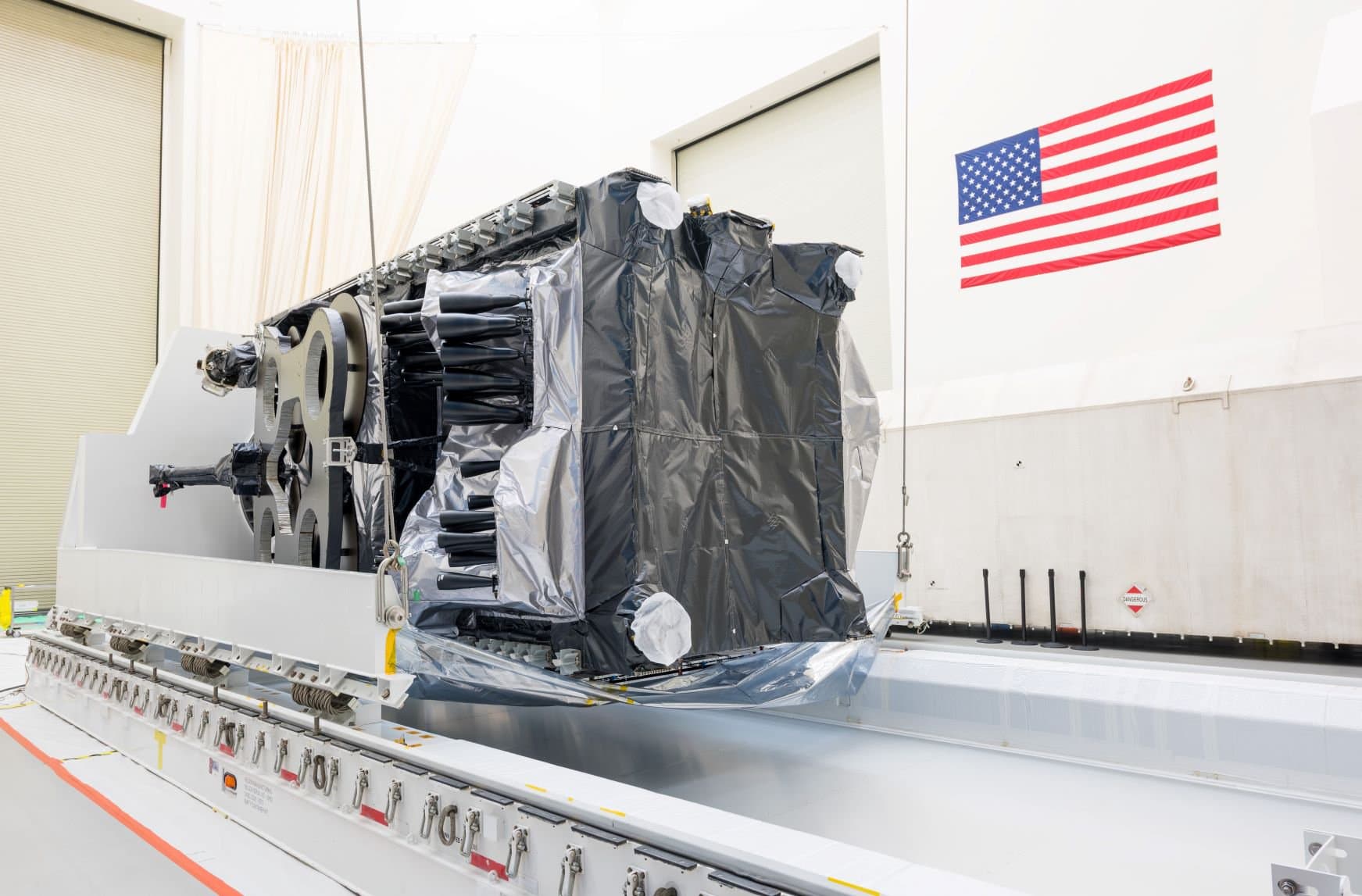Osłony minęły statki odbiorcze 17.12. o 00:10 z Cape Canaveral wystartowała RN Falcon-9R. Wyniosła ona w T+28' 09" na orbitę o parametrach:
hp=273 km, ha=20319 km, i=26,87° satelitę Kacific 1 (JCSat-18). W T+8' 38" pierwszy stopień wylądował na barce
ASDS OCISLY, natomiast w T+45' obie połówki osłony aerodynamicznej nie zostały przechwycone w locie przez
statki “Ms. Tree” i “Ms. Chief”.
http://lk.astronautilus.pl/n191216.htm#02 Udany start Falcona 9 z JCSAT-18/Kacific-1
Udany start Falcona 9 z JCSAT-18/Kacific-1 BY KRZYSZTOF KANAWKA ON 18 GRUDNIA 2019
 Tuż przed startem Falcona 9 - 17.12.2019 / Credits - SpaceX
Tuż przed startem Falcona 9 - 17.12.2019 / Credits - SpaceXSiedemnastego grudnia 2019 rakieta Falcon 9 wyniosła satelitę telekomunikacyjnego JCSAT-18/Kacific-1. Po wykonanej pracy pierwszy stopień rakiety wylądował na platformie morskiej.
Do startu rakiety Falcon 9 doszło 17 grudnia o godzinie 01:10 CET. Start nastąpił z wyrzutni LC-40 na Florydzie. Na pokładzie rakiety Falcon 9 znalazł się satelita telekomunikacyjny JCSAT-18/Kacific-1. Lot przebiegł prawidłowo i 35 minut po starcie satelita został uwolniony na orbicie transferowej GTO, skąd “o własnych siłach” dotrze do orbity geostacjonarnej (GEO).
Relacja ze startu Falcona 9 z JCSAT-18/Kacific-1 / Credits – SpaceX
Po wykonanej pracy pierwszy stopień rakiety Falcon 9 z powodzeniem wylądował na platformie morskiej. Lądowanie nastąpiło około 8 minut i 30 sekund po starcie.
 Pierwszy stopień rakiety Falcon 9 po lądowaniu na platformie morskiej / Credits – SpaceX
Pierwszy stopień rakiety Falcon 9 po lądowaniu na platformie morskiej / Credits – SpaceXSatelita JCSAT-18/Kacific-1 ma masę startową 6956 kg. Jest to przykład bardzo ciężkiego satelity telekomunikacyjnego wyposażonego w duży zestaw anten i transponderów. Na pokładzie tego satelity zamontowano 56 wiązek na paśmie Ka, z których każdy jest w stanie przesyłać do 1,25 Gbps. Jest to aktualnie “najszybszy” satelita telekomunikacyjny w transmisji danych na paśmie Ka. Co ciekawe, jeszcze przed startem prawie 3/4 wiązek tego satelity zostało zarezerwowanych przez różnych klientów z regionu wschodniej Azji.
Był to 11 start rakiety Falcon 9 w 2019 roku. Na ostatni dzień 2019 roku firma SpaceX zaplanowała kolejny start swoich satelitów Starlink.
(PFA, SpaceX)
https://kosmonauta.net/2019/12/udany-start-falcona-9-z-jcsat-18-kacific-1/#prettyPhotoStartup launches broadband satellite on SpaceX rocket to connect Pacific islandsDecember 17, 2019 Stephen Clark
 SpaceX’s Falcon 9 rocket streaks downrange from Cape Canaveral Monday night with the JCSAT 18/Kacific 1 communications satellite. Credit: SpaceX
SpaceX’s Falcon 9 rocket streaks downrange from Cape Canaveral Monday night with the JCSAT 18/Kacific 1 communications satellite. Credit: SpaceX(...) The Falcon 9’s payload shroud also jettisoned right on time after the rocket soared above the dense, lower layers of the atmosphere. Two recovery ships deployed by SpaceX were on station in the Atlantic to try to retrieve the two halves of the fairing as they descended under parachutes, but SpaceX said the vessels narrowly missed catching the two pieces of the nose cone with their giant nets.
Instead, SpaceX said the recovery team will try to recover the fairing halves from the sea for potential refurbishment and reuse on a future launch. (...)
 SpaceX’s Falcon 9 rocket lifts off at 7:10 p.m. EST Monday (0010 GMT Tuesday) with the JCSAT 18/Kacific 1 communications satellite on-board. Credit: Stephen Clark/Spaceflight Now
SpaceX’s Falcon 9 rocket lifts off at 7:10 p.m. EST Monday (0010 GMT Tuesday) with the JCSAT 18/Kacific 1 communications satellite on-board. Credit: Stephen Clark/Spaceflight Now(...) Boeing officials confirmed the 15,335-pound (6,956-kilogram) radioed its status to ground teams after arriving in orbit Monday night.
The new spacecraft is a shared asset between Kacific and Sky Perfect JSAT Corp., an established satellite operator based in Tokyo. Kacific will take the satellite’s Ka-band capacity, and Sky Perfect JSAT controls the craft’s Ku-band payload.
Kacific, headquartered in Singapore, was founded in 2013 by Christian Patouraux, then a 20-year satellite industry veteran with experience in satellite engineering and business strategy development.
“Our vision is very much to bridge the digital divide, to drive economic development,” Patouraux said in a pre-launch media briefing Monday. “The World Bank has shown evidence that if you provide connectivity you have a direct impact, a signifiant impact on economic growth. We will do that throughout the Asia-Pacific.”
“It will be really a game-changer deep inside society,” Patouraux said of Kacific 1. “And it will provide a public service that will also connect all kinds of government services, not only schools and hospitals but you can also think of connecting post offices delivering ID cards and passports — locally inside villages — as well as police stations and fire stations.””
Kacific has leased capacity on third-party satellites to begin realizing its vision of beaming broadband connectivity to millions of underserved people across the Asia-Pacific region. Now, after some financial maneuvering, loans and equity fundraising, Kacific has its own satellite infrastructure in orbit.
“It’s been six-and-a-half years of hard work to get here,'” Patouraux. ‘The most difficult part was really to get financing in a project like this.”
 The JCSAT 18/Kacific 1 communications satellite. Credit: Kacific
The JCSAT 18/Kacific 1 communications satellite. Credit: KacificAccording to Patouraux, Kacific invested more than $200 million in developing its part of the JCSAT 18/Kacific 1 mission, including Kacific’s share of the launch costs, satellite production costs, and ground systems. (...)
During its planned 15-year mission, JCSAT 18/Kacific 1 will be parked at 150 degrees east longitude, giving the satellite an expansive coverage zone stretching across the Asia-Pacific.
Patouraux said region covered by Kacific’s Ka-band payload is home to some 600 million people.
“Connecting communities gives them access to emergency healthcare, gives them access to evacuation,” said Patouraux. “They’re living in very precarious areas of the world that are prone to hurricanes, to earthquakes, landslides, tsunamis, volcanic eruptions.
“This is what Kacific is designed for specifically,” he said. “It’s a high-throughput satellite. It’s composed of 56 high-power beams that create an equivalent of a cellular network from space using frequencies and spectrum again and again from spot-to-spot across those 56 spot beams. It’s transmitting over high-power Ka-band, hence the name Kacific, Ka-band for the Pacific … And it has gateways to connect the satellite to high-speed backbone Internet in Australia, in the Philippines and in Indonesia.”
Kacific says its Ka-band payload will cover a swath from Nepal in the west to French Polynesia in the east, and from the Philippines in the north to New Zealand in the south. The coverage zone includes 25 countries.
Users with good ground antennas will be able to achieve download speeds of up to 50 to 100 megabits per second through Kacific’s network, Patouraux said.
While Kacific uses the new satellite’s Ka-band payload, Sky Perfect JSAT will simultaneously bring online the spacecraft’s Ku-band systems to provide mobile and broadband communication services over Japan and the broader Asia-Pacific region, with a coverage range extending from Indonesia and Southeast Asia to coastal China and Eastern Russia.
https://spaceflightnow.com/2019/12/17/startup-launches-broadband-satellite-on-spacex-rocket-to-connect-pacific-islands/https://spaceflightnow.com/2019/12/13/spacex-performs-hold-down-firing-for-heavyweight-satellite-launch-monday/https://spaceflightnow.com/2019/12/16/falcon-9-launch-timeline-with-jcsat-8-kacific-1/Falcon 9 launches condosat mission for Kacific and Sky Perfect JSATby Caleb Henry — December 16, 2019
 JCSAT-18/Kacific-1 separating from the Falcon 9 rocket's upper stage. Credit: SpaceX
JCSAT-18/Kacific-1 separating from the Falcon 9 rocket's upper stage. Credit: SpaceXWASHINGTON — SpaceX launched a communications satellite shared by two companies Dec. 16 using a Falcon 9 rocket.
The rocket lifted off at 7:10 p.m. Eastern from Cape Canaveral, Florida, and deployed the JCSAT-18/Kacific-1 satellite into a geostationary transfer orbit 33 minutes later.
The Falcon 9’s first-stage booster, previously used for NASA cargo runs to the International Space Station in May and July, landed on the Atlantic droneship
Of Course I Still Love You almost nine minutes into the mission, returning to Earth for the third time.
SpaceX said its fairing recovery ships
Ms. Tree and Ms. Chief “narrowly missed catching the fairing halves” from the launch, but that SpaceX is still working to recover them from the ocean for potential use on a future flight.
JCSAT-18/Kacific-1 is a 6,800-kilogram condominium satellite, or “condosat” from Boeing, equipped with distinct payloads for Japanese operator Sky Perfect JSAT and Singaporean startup Kacific.
For Sky Perfect JSAT, the JCSAT-18 payload will provide Ku- and Ka-band capacity over large parts of the Asia-Pacific, including Russia’s Far East. It is the 18th geostationary satellite in the operator’s fleet, and second with high-throughput capacity, enabling higher speed broadband services than traditional satellites.
Kacific-1 is an all Ka-band payload with high-throughput coverage designed for island nations that lack dedicated satellite coverage. Kacific says the payload’s 56 spot beams will cover 600 million people spread across 25 countries.
Kacific-1 is Kacific’s first satellite, and almost didn’t happen because of difficulty attracting capital. Christian Patouraux, Kacific’s CEO, said that for its first three years he felt the company was constantly within a month of collapsing.
“There were ups and downs,” he said during a Dec. 16 press conference. “There were roller coasters.”
Kacific formed in 2013, he said. When Kacific ordered Kacific-1 in 2017, it had to do so without help from the U.S. Export-Import Bank, which lacked the minimum number of Senate-confirmed board members required to finance deals over $10 million.
Patouraux said Kacific raised $67 million in equity for the satellite through family offices — many backed by high-net-worth individuals — to finance the satellite. Kacific also used short term debt, which it refinanced with $160 million in new debt announced Dec. 5.
Patouraux said Kacific contracted 11 transponders of Ku-band capacity from European and Asian satellite operators so it could serve customers in Vanuatu, Samoa, Timor Leste, and elsewhere while waiting for Kacific-1.
Kacific selected Kratos to build gateway ground stations in Indonesia, Australia and the Philippines to support Kacific-1. After all the work required to launch a first satellite, Patouraux said it would be much easier to order and launch a second satellite, which the company plans to do pending board approval.
“It would almost be silly not to try to replicate that and do it in faster time with a better cost of capital,” he said.
Patouraux said a Kacific-2 satellite would augment Kacific-1 capacity while expanding westward across Asia and possibly Africa. He did not give a timeline for Kacific-2.
https://spacenews.com/falcon-9-launches-condosat-mission-for-kacific-and-sky-perfect-jsat/SpaceX Launches JCSAT-18 / Kacific-1 for Asia-Pacific RegionBy Ben Evans, on December 16th, 2019
(...) As outlined in AmericaSpace’s preview article, the first-stage core for the JCSAT-18/Kacific-1 mission was B1056, which previously supported the CRS-17 and CRS-18 Dragon launches in May and July 2019. (...)
 The heavyweight JCSAT-18/Kacific-1 communications satellite, pictured here, tips the scales at almost 15,000 pounds (6,800 kg). Photo Credit: Kacifichttps://www.americaspace.com/2019/12/16/spacex-launches-jcsat-18-kacific-1-for-asia-pacific-region/https://www.nasaspaceflight.com/2019/12/spacex-falcon-9-launch-jcsat-18-kacific-1/
The heavyweight JCSAT-18/Kacific-1 communications satellite, pictured here, tips the scales at almost 15,000 pounds (6,800 kg). Photo Credit: Kacifichttps://www.americaspace.com/2019/12/16/spacex-launches-jcsat-18-kacific-1-for-asia-pacific-region/https://www.nasaspaceflight.com/2019/12/spacex-falcon-9-launch-jcsat-18-kacific-1/JCSat 18 / Kacific 1
https://space.skyrocket.de/doc_sdat/jcsat-18_kacific-1.htm